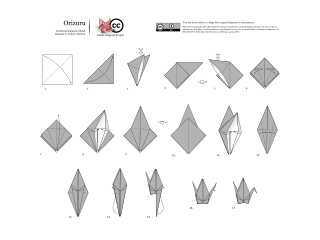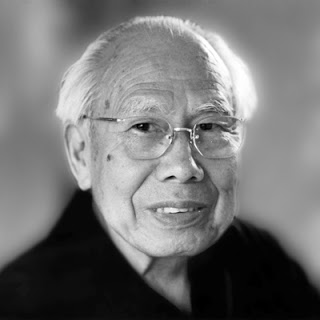Related Research Articles

Origami is the art of paper folding, which is often associated with Japanese culture. In modern usage, the word "origami" is used as an inclusive term for all folding practices, regardless of their culture of origin. The goal is to transform a flat square sheet of paper into a finished sculpture through folding and sculpting techniques. Modern origami practitioners generally discourage the use of cuts, glue, or markings on the paper. Origami folders often use the Japanese word kirigami to refer to designs which use cuts.

The Yoshizawa–Randlett system is a diagramming system used to describe the folds of origami models. Many origami books begin with a description of basic origami techniques which are used to construct the models. There are also a number of standard bases which are commonly used as a first step in construction. Models are typically classified as requiring low, intermediate or high skill depending on the complexity of the techniques involved in the construction.

The discipline of origami or paper folding has received a considerable amount of mathematical study. Fields of interest include a given paper model's flat-foldability, and the use of paper folds to solve up-to cubic mathematical equations.

Modular origami or unit origami is a paperfolding technique which uses two or more sheets of paper to create a larger and more complex structure than would be possible using single-piece origami techniques. Each individual sheet of paper is folded into a module, or unit, and then modules are assembled into an integrated flat shape or three-dimensional structure, usually by inserting flaps into pockets created by the folding process. These insertions create tension or friction that holds the model together.

Robert Harbin was a British magician and author. He is noted as the inventor of a number of classic illusions, including the Zig Zag Girl. He also became an authority on origami.

Chinese paper folding, or zhezhi, is the art of paper folding that originated in medieval China.

A paper plane is a toy aircraft, usually a glider made out of single folded sheet of paper or paperboard. A simple nose-heavy paper plane, thrown like a dart, is also known as a paper dart.

Akira Yoshizawa was a Japanese origamist, considered to be the grandmaster of origami. He is credited with raising origami from a craft to a living art. According to his own estimation made in 1989, he created more than 50,000 models, of which only a few hundred designs were presented as diagrams in his 18 books. Yoshizawa acted as an international cultural ambassador for Japan throughout his career. In 1983, Emperor Hirohito awarded him the Order of the Rising Sun, 5th class, one of the highest honors bestowed in Japan.

Paper craft is a collection of crafts using paper or card as the primary artistic medium for the creation of two or three-dimensional objects. Paper and card stock lend themselves to a wide range of techniques and can be folded, curved, bent, cut, glued, molded, stitched, or layered. Papermaking by hand is also a paper craft.

Origamic Architecture is a form of kirigami that involves the three-dimensional reproduction of architecture and monuments, on various scales, using cut-out and folded paper, usually thin paperboard. Visually, these creations are comparable to intricate 'pop-ups', indeed, some works are deliberately engineered to possess 'pop-up'-like properties. However, origamic architecture tends to be cut out of a single sheet of paper, whereas most pop-ups involve two or more. To create the three-dimensional image out of the two-dimensional surface requires skill akin to that of an architect.

The Japanese kusudama is a paper model that is usually created by sewing multiple identical pyramidal units together through their points to form a spherical shape. Alternately the individual components may be glued together. Occasionally, a tassel is attached to the bottom for decoration.

The history of origami followed after the invention of paper and was a result of paper's use in society. Independent paper folding traditions exist in East Asia, and it is unclear whether they evolved separately or had a common source.

Origami paper is used to fold origami, the art of paper folding. The only real requirement of the folding medium is that it must be able to hold a crease, but should ideally also be thinner than regular paper for convenience when multiple folds over the same small paper area are required.
Thomas C. Hull is an associate professor of mathematics at Western New England University and is known for his expertise in the mathematics of paper folding.
OrigamiUSA is the largest origami organization in the United States, with offices located at the American Museum of Natural History in New York City. It was founded in 1980 by Michael Shall, Alice Gray, and Lillian Oppenheimer as the Friends of the Origami Center of America and was renamed OrigamiUSA on July 1, 1994. Since its founding, OrigamiUSA has been fully non-profit and volunteer-based and is a 501(c)(3) corporation. OrigamiUSA organizes the largest origami convention in the world each June in New York City, and in addition publishes a magazine, The Paper, an annual collection of origami diagrams, and a website, and also provides educational materials and supports numerous other activities that spread the art of origami.
Paper toys are toys made of paper. They are constructed in several ways, by folding, as in paper airplanes, paper fortune tellers or Origami, or by cutting, decorating or assembling pieces of paper with glue or tape to create a paper doll or paper model.
Jun Maekawa is a Japanese software engineer, mathematician, and origami artist. He is known for popularizing the method of utilizing crease patterns in designing origami models, with his 1985 publication Viva Origami, as well as other paperfolding-related theorems and mathematical analysis. One of them being Maekawa's theorem in relation to the flat-foldability of origami models.

Paper Mario: The Origami King is a 2020 cross-genre video game released exclusively for the Nintendo Switch console. Developed by Intelligent Systems and published by Nintendo, it is the sixth game in the Paper Mario series, part of the larger Mario franchise. The story follows Mario and his friends as he sets out on a journey to prevent the Mushroom Kingdom from being transformed into origami. To do so, Mario must free Princess Peach's castle from five decorative streamers that extend across the kingdom.
Tomohiro Tachi is a Japanese academic who studies origami from an interdisciplinary perspective, combining approaches from the mathematics of paper folding, structural rigidity, computational geometry, architecture, and materials science. His work was profiled in "The Origami Revolution" (2017), part of the Nova series of US science documentaries. He is an associate professor at the University of Tokyo.
References
- ↑ "Sipho Mabona can fold paper better than you". MyConfinedSpace. 2009-10-05. Retrieved 2022-05-05.
- ↑ Sipho Mabona. "In the Pursuit of Perfection video" . Retrieved 2009-09-30.